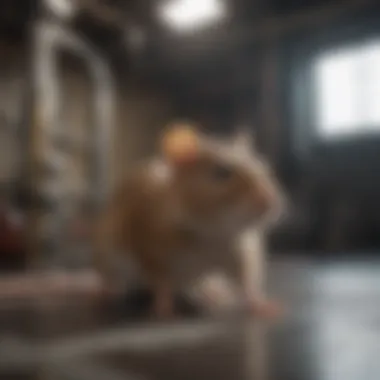Industrial Rodent Repellent Solutions Explored


Intro
Rodents pose significant challenges in various industrial settings, making effective rodent management crucial. Industrial spaces, including warehouses, factories, and food production facilities, require specialized strategies to combat these pests. Understanding the behaviors and characteristics of rodents is essential to develop solutions that work effectively while minimizing negative environmental impacts. This article provides a thorough analysis of rodent repellent solutions, examining their mechanisms, applications, and practical implementation across different sectors. By employing a comprehensive approach, we can shed light on the diverse methods available for pest management.
Understanding Pests
Definition of Pests
Pests are organisms that disrupt human activity, cause damage to property, or threaten health. Rodents, specifically, are members of the order Rodentia, characterized by their continuously growing incisors. Common species in industrial environments include the house mouse, Norway rat, and roof rat. Understanding these pests is the first step towards effective management strategies.
Importance of Pest Identification
Identification of specific rodent species is critical for targeting management practices. Different species exhibit varying behaviors, reproductive rates, and habitat preferences. For instance, Norway rats tend to inhabit burrows near water sources, while house mice may nest in walls or cavities. Proper identification allows industries to tailor their approaches, optimizing effectiveness and reducing the likelihood of infestation.
Prevention Techniques
Understanding Exclusion and Sanitation
Preventive measures form the foundation of effective rodent control. Proper sanitation and structural integrity are essential to limit rodent access and reproduction. Regular cleaning and minimizing clutter can help create an environment that is less appealing to rodents.
Structural Enhancements
- Seal cracks and gaps in building exteriors.
- Install screens on vents and openings.
- Use door sweeps to close gaps under doors.
These structural enhancements not only help keep rodents out but also maintain the integrity of the workspace, enhancing overall hygiene.
Eco-Friendly Pest Control Solutions
Overview of Sustainable Practices
Sustainable pest management incorporates eco-friendly methods that minimize harm to the environment. This approach is particularly important in industries such as food production, where chemical treatments may have unintended consequences.
Natural Remedies and Their Effectiveness
Certain natural remedies have shown promise in repelling rodents:
- Peppermint Oil: Known for its strong scent, peppermint oil can deter rodents when applied around entry points.
- Cayenne Pepper: Sprinkling cayenne pepper in infested areas may discourage rodent activity due to its pungent nature.
While these methods can be effective, their application should complement other strategies for a holistic approach.
Important: Combining multiple techniques often results in better pest management outcomes.
Prelims to Industrial Rodent Control
Industrial rodent control is a crucial element of maintaining operational efficiency and compliance within various sectors. Rodents pose significant challenges to industries, impacting not only physical facilities but also the overall productivity and health of the ecosystem in which they operate. The discussion around rodent control encapsulates various strategies and methodologies aiming to mitigate the risks associated with rodent infestations.
Understanding Rodent Behavior
Rodent behavior is complex and varies among species. Generally, rodents are highly adaptable creatures. They tend to thrive in environments where food and shelter are readily available. Understanding the habits of rodents is fundamental for effective control. Rodents can reproduce quickly, with females able to breed multiple times in a year, leading to rapid population growth. Their gnawing and nesting behaviors can cause significant damage to structures, equipment, and products. Therefore, knowing how they operate is essential for devising effective deterrents and management strategies. Keeping environments clean and reducing access to food sources is effective in discouraging rodent activity, but it also requires ongoing vigilance from management.
Significance of Rodent Management in Industries
Effective rodent management is of paramount importance in industrial settings. The presence of rodents can lead to contamination and spoilage of products, impacting both consumer safety and business integrity. Furthermore, rodent infestations may trigger health inspection violations, which result in hefty fines and damage to reputation.
Implementing a robust rodent management strategy confers multiple benefits:
- Protection of Assets: Safeguarding infrastructure and equipment from rodent-related damage.
- Safety Assurance: Maintaining a hygienic environment to promote health and safety for employees and consumers.
- Operational Continuity: Minimizing disruptions caused by infestations or the need for intensive cleanups.
Types of Industrial Rodent Repellents
Understanding the various types of industrial rodent repellents is crucial for effective management of rodent populations in various settings. It is not just about getting rid of pests; it is also about ensuring the longevity and safety of the facilities involved. Each type of repellent offers unique advantages and challenges that industries must consider when developing their pest control strategies. With the right information, decision-makers can choose the most suitable solutions that align with their operational needs and safety standards.
Chemical Repellents
Chemical repellents are among the most common tools used in industrial rodent control. These products typically contain substances that disrupt rodent senses, deterring them from entering or nesting in certain areas. The effectiveness of chemical repellents often hinges on their formulation, where specific components are designed to either mimic odors that rodents typically avoid or create an uncomfortable environment for them.


Advantages:
- Immediate results: Many chemical repellents can provide rapid relief, reducing rodent presence quickly.
- Wide application range: These repellents can be utilized in various settings from warehouses to transportation hubs.
- Scalability: They can be easily scaled according to the size of the area needing protection.
Considerations:
- Health concerns: Some chemicals can pose hazards to humans and non-target animals.
- Regulation compliance: Users must ensure adherence to all safety and environmental regulations, as misuse can have legal consequences.
Biological Repellents
Biological repellents leverage natural substances to repel rodents without the harmful side effects often associated with chemical options. These products may include essential oils and pheromones produced by various plants and animals specifically deterrent to rodents.
Advantages:
- Eco-friendliness: Biological repellents are often biodegradable and do not harm the environment.
- Non-toxic nature: They are generally considered safer for both humans and pets, making them suitable for sensitive environments.
Considerations:
- Effectiveness in varying conditions: While some biological repellents work well in certain climates, their success may vary, affecting overall effectiveness.
- Variable duration of effect: Unlike chemical options, biological repellents may need to be reapplied more frequently.
Electronic Repellent Devices
Electronic repellents are an innovative solution that uses sound, light, or electromagnetic fields to deter rodents. These devices create an uncomfortable environment for the rodents, often causing them to flee the area. Such repellents can be particularly effective if installed in strategic locations within facilities.
Advantages:
- No toxic substances: As these devices do not use any chemicals, they present no health risks to humans or pets.
- Continuous operation: Many devices can run constantly, providing 24/7 protection against rodent incursions.
Considerations:
- Initial investment: The upfront costs for electronic devices can be higher than traditional methods.
- Potential ineffectiveness: Some rodent species adapt to the noise over time, potentially diminishing the device's effectiveness.
"Choosing the ideal type of rodent repellent for an industrial setting requires careful consideration of the environment, the specific rodent species, and regulatory requirements."
Mechanisms of Action of Rodent Repellents
Understanding the mechanisms of action in rodent repellents is crucial for effective pest management. These mechanisms explain how different repellents deter rodents and provide insights into their efficacy. Recognizing the underlying principles enables industries to select appropriate deterrents tailored to their specific challenges with rodent infestations. Well-informing on these mechanisms can enhance the effectiveness of rodent control programs, helping save resources and promoting a healthier environment.
Sensory Deterrence
Sensory deterrence refers to the way certain repellents interfere with rodents' sensory systems. Rodents rely heavily on their senses to navigate environments, find food, and assess threats. Repellents that target these senses can effectively disrupt normal rodent behavior. Common sensory deterrents include:
- Odor repellents: Many repellents emit strong smells that are unpleasant to rodents but not necessarily detectable by humans. Ingredients like peppermint oil or predator urine can cause rodents to avoid areas where these scents are present.
- Sound deterrents: Electronic devices that emit high-frequency sounds can disturb rodents. They are often marketed as sonic pest repellents. Rodents, having sensitive hearing, may be induced to leave areas where they perceive threats.
- Taste aversion: Some chemical repellents have a bitter taste that deters rodents from consuming bait or dwelling in treated zones.
The effectiveness of sensory deterrence can vary due to environmental factors. For instance, strong winds can disperse odors, reducing deterrent effects. Additionally, habituation may occur as rodents become accustomed to certain scents or sounds over time. Therefore, continuous monitoring and adjustment of approaches are essential to maintain effectiveness.
Behavioral Modification
Behavioral modification focuses on altering rodents' habits or patterns through specific repellent strategies. Instead of simply deterring rodents temporarily, these methods aim at changing their behavior over time, leading to long-lasting pest control. Key strategies for behavioral modification include:
- Habitat alteration: By manipulating the environment, companies can make spaces less appealing to rodents. This may involve removing food sources, closing entry points, or altering landscaping to eliminate shelter options.
- Aversion conditioning: This method employs aversive stimuli along with food rewards. For instance, animals can be conditioned to associate a bad experience with a previously preferred food source, encouraging them to seek alternative options.
- Community involvement: Participating communities in pest management efforts can influence behaviour on a larger scale. Informing and educating residents on maintaining cleanliness and minimizing food sources will further contribute to effective rodent control.
"Effective rodent repellent strategies rely not just on physical barriers, but on understanding rodent behavior and sensory responses to deterrents."
Incorporating a blend of sensory deterrence and behavioral modification strategies can lead to a comprehensive pest management approach that enhances effectiveness while considering environmental impacts.
Regulatory Considerations
The role of regulatory considerations in industrial rodent control becomes increasingly pronounced as industries seek effective methods for pest management. These considerations not only ensure efficacy in repellent measures, but also align practices with legal and environmental standards. Understanding the regulations surrounding rodent repellent solutions is crucial for industries aiming to mitigate risks associated with rodent infestations and to protect their operations alongside ecological health.
Compliance with Environmental Regulations
Adherence to environmental regulations is often paramount in industrial practice. Various agencies, such as the Environmental Protection Agency (EPA) in the United States, set guidelines for the safe use of chemicals, including rodent repellents. These rules aim to minimize ecological impact, human health risks, and facilitate sustainable practices. Industries must meet specific criteria, ensuring that the products used do not introduce harmful substances into the environment.
Regulatory compliance presents notable benefits:


- Legal Protection: Following regulations helps companies avoid fines and legal complications.
- Trust and Credibility: Eco-conscious consumers increasingly prefer companies that prioritize environmental safety.
- Operational Security: Compliance can lead to enhanced safety protocols that protect both employees and the surrounding community.
Safety Standards for Use
Safety standards in the use of rodent repellents are vital in preventing mishaps during both application and post-application phases. These standards often dictate safe handling practices, storage conditions, and usage instructions for both chemical and biological repellents. Moreover, manufacturers are required to provide Material Safety Data Sheets (MSDS) that outline potential hazards and recommended safety measures.
Key safety considerations include:
- Personal Protective Equipment (PPE): Ensuring workers use appropriate gear can significantly reduce health risks.
- Training Programs: Educating staff on safe handling and emergency procedures encourages responsible management of materials.
- Health Monitoring: Regular health assessments can identify potential adverse effects promptly and ensure a safe working environment.
"Effective rodent management hinges not only on choosing the right solutions but also on meeting the safety and regulatory frameworks that govern their use."
Applications of Industrial Rodent Repellents
The application of industrial rodent repellents is critical in various sectors, aiming to mitigate the persistent threat of rodent infestations. These pests can cause significant damage to property, contaminate products, and pose health risks in industrial environments. Understanding how these repellents work in specific applications ensures better pest management and enhances overall operational efficiency.
Manufacturing Facilities
Manufacturing facilities often present the ideal environment for rodents due to the abundance of raw materials and packaging supplies. The presence of food waste and shelter can attract rodents, leading to potential disruptions. Effectively deploying rodent repellents helps maintain a clean production area, safeguarding the integrity of products.
A suitable solution in these settings includes electronic repellent devices, which can create a sonic barrier to deter rodents without physical traps or poisons. Regular inspections should complement these repellents. Monitoring might include checking for signs of rodent activity or damage.
Food Processing Industries
In food processing industries, keeping a pest-free environment is paramount. Rodents can compromise food safety, leading to contamination and serious foodborne illnesses. Therefore, the application of reliable rodent repellents here is non-negotiable. Chemical repellents designed specifically for food settings can offer deterrence while adhering to safety protocols.
Training staff in recognizing rodent behavior and the signs of infestations helps to enhance these efforts. Moreover, integrating biological repellents that are safe for food areas contributes to protecting both worker health and food safety.
Warehousing and Transportation
Warehousing and transportation sectors also face rodent challenges. Warehouses store various goods, presenting a buffet for rodents if not managed. Using a mix of chemical and electronic repellents can help protect the integrity of the stored products. Understanding the layout helps tailor the deployment of these solutions. Place electronic devices at entry points and near potential food sources.
Additionally, regular cleaning schedules and waste management practices must be enforced to minimize attractants. Collaboration with transportation teams is vital to ensure vehicles are rodent-free before loading and unloading goods.
In summary, recognizing the varied applications of industrial rodent repellents across sectors like manufacturing, food processing, and warehousing is essential for effective pest management. Each environment requires tailored approaches to repel rodents and protect assets.
Effectiveness of Rodent Repellents
The effectiveness of rodent repellents stands as a critical pillar in pest management strategies within industrial contexts. Industries face substantial risks if rodent populations are allowed to thrive. Such risks include contamination of products, damage to infrastructure, and potential health hazards for workers. Therefore, understanding the factors that contribute to the success of rodent repellents is essential for developing effective management strategies. This section will discuss key elements influencing their effectiveness, supported by a comparative analysis of existing studies.
Factors Influencing Repellent Success
The success of rodent repellents largely depends on several factors. Firstly, formulation plays a vital role; the chemical composition can determine how effectively a repellent works in different environments. For example, some chemical repellents may perform better in open spaces, while others are more suited for confined areas. Additionally, application method matters greatly. A poorly applied repellent may show insufficient deterrence, regardless of its active ingredients.
Another significant factor is environmental conditions. Variables such as temperature, humidity, and the presence of competing food sources can affect a repellent's efficiency. In damp environments, some repellents may degrade faster, leading to reduced efficacy. Conversely, rodent behavior cannot be overlooked. Different species show varied responses to repellents. Some may quickly adapt to certain smells or sounds, reducing the effectiveness of the applied repellent over time.
Finally, it's important to consider the frequency and timing of application. Regular monitoring and reapplication can enhance repellent durability and effectiveness. A well-timed application can prevent rodents from entering before they establish nests or breeding sites.
Comparative Efficacy Studies
To better understand the effectiveness of different types of rodent repellents, comparative efficacy studies can provide invaluable insights. Research has shown notable differences in performance among chemical, biological, and electronic repellents. For instance, a study highlighted that while certain natural repellents like peppermint oil may have immediate effects, their long-term efficacy may not be comparable to synthetic options.
In other cases, electronic devices like ultrasonic repellents have shown promise but received mixed reviews regarding their impact on different rodent species. Studies have documented varying success rates, with rodents often habituating to ultrasonic sounds over time. These studies emphasize the need for a multifaceted approach to rodent management, integrating various methods tailored to specific environments and rodent types.
Overall, assessing the effectiveness of rodent repellents is not merely about identifying a single best product. It necessitates a comprehensive understanding of various factors and considerations that inform strategic decisions for rodent control within industrial settings.
"Success in rodent repellents often hinges on a combination of proper formulation, application methods, and environmental conditions."
Employing a holistic view will empower industries to select the most appropriate solutions for their unique challenges, thereby minimizing the risk posed by rodent infestations.
Case Studies in Industrial Applications
Case studies in industrial rodent applications offer critical insights into real-world challenges and solutions in rodent management. Understanding how different establishments face rodent issues can inform better practices and introduce innovative approaches. By analyzing specific instances, industries can derive lessons that enhance operational effectiveness.
Examining case studies also reveals the outcomes of implementing various rodent repellent solutions. This exploration encompasses successes and setbacks, paving a comprehensive path towards effective rodent control. Businesses gain a dual advantage; they not only learn from successful implementations but also identify pitfalls to avoid in their own strategies.


Successful Implementation Stories
Successful case studies illustrate how industries have effectively utilized rodent repellents, showcasing practical applications that resulted in significant improvements. For instance, a large manufacturing facility in Ohio faced considerable rodent challenges due to its expansive layout. They adopted a multi-faceted approach that combined chemical repellents with electronic devices. After six months, the facility reported a remarkable 70% reduction in rodent sightings. This result underscores the potential benefits when integrated strategies are employed.
Similarly, a food processing plant in California implemented a natural repellent solution derived from essential oils. After establishing a monitoring system, they noticed a marked decrease in rodent activity compared to previous years. These stories reflect the importance of customization and adaptability in selecting the most appropriate repellent methods for specific environments.
"Analyzing successful strategies helps other industries understand which facets make a comprehensive rodent control plan effective."
Lessons Learned from Failures
Not all case studies end positively. Failures, while difficult to digest, can be invaluable for learning. One notable example involved a warehousing company in Texas that opted predominantly for electronic repellents. Despite initial excitement, the rodents adapted over time, rendering the devices ineffective. The lack of a varied approach led to a resurgence in rodent populations, culminating in a costly reevaluation of their strategy.
This highlights the danger of relying exclusively on one method. A combination of repellents, regardless of type, generally yields improved results. In another case, a leading agricultural firm adopted a new chemical repellent without thorough research into its long-term effects or environmental impact. This decision resulted in regulatory fines and a tarnished reputation. In essence, in the quest to combat rodents, learning from failures is as crucial as celebrating successes.
Eco-Friendly Alternatives
The relevance of eco-friendly alternatives in industrial rodent repellent solutions cannot be underestimated. As industries move toward sustainability, the focus has shifted to methods that do not harm the environment while effectively managing rodent populations. Eco-friendly approaches emphasize reliance on natural materials and sustainable practices that align with regulatory requirements and community expectations.
Integrating Sustainable Practices
Integrating sustainable practices into rodent management requires an understanding of how these practices can positively impact both the environment and operational efficiency. This means assessing the entire lifecycle of repellents used in industrial settings. Companies can adopt strategies such as:
- Utilizing biodegradable materials in repellent formulations.
- Implementing pest management programs that minimize the use of harsh chemicals.
- Adopting integrated pest management (IPM) systems, which focus on prevention through sanitation and habitat modification.
These practices not only promote environmental health but also enhance the reputation of businesses, appealing to eco-conscious consumers and regulatory bodies. Furthermore, they can reduce operational costs by minimizing reliance on expensive chemical treatments.
Natural Repellent Solutions
Natural repellent solutions present a significant alternative to traditional chemical repellents. These solutions often include essential oils, plant extracts, and other organic substances known for their deterrent properties against rodents. Popular choices include:
- Peppermint Oil: Known for its strong aroma, peppermint oil is often used in various formulations to repel rodents effectively.
- Cayenne Pepper: Adding cayenne pepper to habitats discourages rodent entry due to its sharp sensation.
- Garlic Powder: This is another natural item that creates an unpleasant atmosphere for rodents.
The appeal of natural solutions lies not only in their effectiveness but also in their safety for humans and pets. They reduce the risk of harmful exposure that can occur with synthetic chemicals, making them an attractive choice for both industrial and domestic environments. As industries explore eco-friendly alternatives, the adoption of natural repellent solutions could pave the way for a safer and more sustainable approach to pest management.
Future Trends in Rodent Repellent Technology
Future trends in rodent repellent technology signal a pivotal shift in how industries approach pest management. As the understanding of rodent behavior and the impact of repellents evolves, there is a crucial need to adopt innovative methods that are both effective and environmentally conscious. This section will explore the latest innovations and technological advancements that aim to redefine how we address rodent infestations. The benefits of focusing on future trends are numerous, as they can lead to more sustainable practices, improved safety, and enhanced effectiveness of repellents across various industrial applications.
Innovations in Repellent Formulation
Innovations in repellent formulation reflect a significant development in pest management strategies. Researchers are exploring and developing new active ingredients that are less harmful to the environment while still providing robust deterrence against rodents. Some formulations include naturally derived compounds that can effectively repel rodents without using harsh chemicals. Moreover, these new formulations often come as targeted systems that minimize collateral damage to non-target species.
The advancements in formulation delivery mechanisms, such as microencapsulation, also represent an exciting direction. Microencapsulation allows for long-lasting effects by protecting active ingredients until they come into contact with target pests. This not only increases the efficacy of the repellent but also reduces the frequency of application required by the end-users, which is crucial for industries striving for efficiency.
In addition, integration with smart technologies enables real-time monitoring and adjustment of repellent application based on environmental factors. This precision increases the overall effectiveness and reduces waste, aligning with sustainable practices in pest control.
Impact of Technological Advances
Technological advances have a multidimensional impact on rodent repellent solutions. One primary area is the integration of IoT (Internet of Things) devices, which allows for continuous monitoring of rodent activity. Smart traps and sensors can detect rodent presence, sending alerts to pest management teams. This data facilitates timely interventions, reducing reliance on preventative chemical treatments.
Furthermore, software analytics enhanced by artificial intelligence can process this data to predict rodent behaviors, helping to develop more efficient preventative strategies. Businesses can optimize their pest management efforts by targeting specific areas that show signs of rodent activity rather than applying products more broadly.
"The future will not only focus on the repellency of products but also on the intelligent integration of technology to understand and address pest behavior more effectively."
The impact extends to system designs in large facilities as well. Automated systems can deploy repellents only when conditions are ideal for rodent activity, conserving resources while also ensuring a focused approach. These efforts represent a significant transition from traditional methods and may contribute to stronger compliance with regulatory frameworks and safety standards.
Epilogue
The conclusion serves as a vital element in this article, encapsulating the major themes and insights regarding industrial rodent repellent solutions. It brings into focus how crucial it is for industries to recognize the multifaceted approach necessary for effective rodent management. Rodents can cause significant harm not only to infrastructure and inventory but also to health and safety standards. Hence, understanding the effectiveness of various repellent methods and their applications is imperative.
Summary of Key Insights
Throughout this article, we explored several important aspects of rodent management, focusing on varied repellent technologies and strategies. Below are the key insights:
- Diverse Types of Repellents: Different types of repellents, including chemical, biological, and electronic devices, each provide unique methods of deterrence.
- Mechanisms of Action: Understanding how these repellents work is essential. They may interfere with rodents' sensory perceptions or alter their behavior, leading to effective pest management.
- Regulatory Compliance: Industries must adhere to environmental regulations and safety standards when implementing these solutions, ensuring they do not pose risks to the environment or human health.
- Case Studies: Documented experiences from various sectors demonstrate the practical effectiveness of these strategies, offering lessons from both successes and failures.
Recommendations for Industry Implementation
Implementing an effective rodent repellent strategy involves careful consideration of several factors. Here are some recommendations for industries:
- Conduct Regular Audits: Regular checks around facilities can help identify vulnerable areas and assess repellent effectiveness.
- Select Suitable Repellents: Choose repellents based on the specific environment and type of rodent infestation. For example, food processing plants often require more stringent controls than warehouses.
- Combine Methods: Using a mix of repellents may enhance overall effectiveness. For instance, combining electronic deterrents with natural repellents can create a more hostile environment for rodents.
- Training and Awareness: Employees should be trained to recognize signs of rodent activity and the necessity of maintaining cleanliness to reduce attractants.
- Monitor and Adapt: Keep track of repellent performance and be prepared to adapt strategies as needed. Continuous improvement is key in pest management.
The importance of a well-rounded approach to rodent management cannot be understated, as it ultimately protects both business interests and public health.



